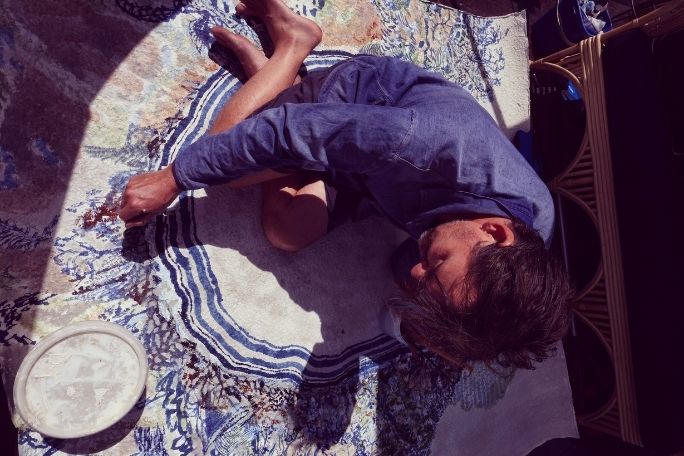Lesson summary
For centuries, artists have travelled in search of new environments to fuel their creativity and to gain perspective on life and the world they live in. Led by intuition, curiosity, and foresight, they have found themselves immersed in nature, painting landscapes and creating mindscapes.
In this art lesson, students investigate how some artists paint using perspective, foreground, middle ground, and background. Whereas other artists have developed a non-traditional approach to sketching and painting. Students will be asked to consider how colour, materials and composition can impact how we perceive art and begin to contemplate why our mood, personality and technique are all essential elements to making art.
Whilst outside in nature, students will create a landscape artwork and are encouraged to look around at the work of their peers and gain inspiration from other artworks. Naturally, students will deviate and find their own path and begin to understand why it can be helpful to have conversations about the creative process and discuss decision-making with friends.
The second part of this art lesson will see students stepping outside their natural comfort zone and completely alter their artwork, and watch it emerge into something else.
Learning intentions:
Students will...
- understand how nature and the environment impacts creativity
- alter an artwork to understand the importance of letting go of ideas associated with perfectionism.
Success criteria:
Students can...
- create artworks that reflect their perception of the natural environment
- relinquish ideas associated with perfectionism when creating artworks.
Lesson guides and printables
Curriculum links
Select your curriculum from the options below.
Lesson details
Curriculum mapping
Australian Curriculum content descriptions:
Years 5 & 6 Visual Arts:
- Develop and apply techniques and processes when making their artworks (ACAVAM115)
- Plan the display of artworks to enhance their meaning for an audience (ACAVAM116)
Years 5 & 6 Visual Arts:
- Experiment with visual arts conventions and techniques, including exploration of techniques used by Aboriginal and Torres Strait Islander artists, to represent a theme, concept or idea in their artwork (ACAVAM118)
- Develop ways to enhance their intentions as artists through exploration of how artists use materials, techniques, technologies and processes (ACAVAM119)
- Practise techniques and processes to enhance the representation of ideas in their art-making (ACAVAM121)
Syllabus outcomes Stage 3: VAS3.1, VAS3.2, VAS3.3, VAS3.4
Syllabus outcomes Stage 4: 4: 4.1, 4.2, 4.4, 4.5, 4.6
General capabilities: Literacy, Personal and social Capabilities, Critical and Creative Thinking
Cross-curriculum priority: Sustainability
Relevant parts of Year 5 & 6 achievement standards:
By the end of Year 6, students explain how ideas are represented in artworks they make and view. They describe the influences of artworks and practices from different cultures, times and places on their art-making.
Students use visual conventions and visual arts practices to express a personal view in their artworks. They demonstrate different techniques and processes in planning and making artworks. They describe how the display of artworks enhances meaning for an audience.
Relevant parts of Year 7 & 8 achievement standards:
By the end of Year 8, students identify and analyse how other artists use visual conventions and viewpoints to communicate ideas and apply this knowledge in their art-making. They explain how an artwork is displayed to enhance its meaning. They evaluate how they and others are influenced by artworks from different cultures, times and places.
Students plan their art-making in response to the exploration of techniques and processes used in their own and others’ artworks. They demonstrate the use of visual conventions, techniques and processes to communicate meaning in their artworks.
This lesson is part of the wider unit of work Lord Howe Island – Artist in Residence
Time required: 90 mins
Level of teacher scaffolding: Medium – facilitate class discussion and how artists use art meta language as they explore traditional and contemporary means of making art
Resources required
- A device capable of presenting a video to the class
- Large sheets of paper suitable for painting and sketching (to be pasted into the art portfolio)
- Paint and pencil for drawing and painting exercise
- Paintbrush
- Portfolio or booklet dedicated to the Joshua Yeldham art lessons
- Student Worksheet (one per person)
- Student resource booklet: Joshua Yeldham Student Resource
Skills
This lesson is designed to build students’ competencies in the following skills:
- Communication
- Creativity
- Cultural understanding
- Critical thinking
- Empathy
- Flexibility
- Problem solving
- Social skills
Additional info
If you would like to access additional information about Joshua Yeldham and the photographs of his wonderful exhibition 'Providence'. Please visit the Arthouse Gallery website: Joshua Yeldham - Providence (arthousegallery.com.au/exhibitions/joshua_yeldham/providence) and the artist's website: Joshua Yeldham (www.joshuayeldham.com.au) for exhibitions and his wonderful book: Surrender (joshuayeldham.com.au/the-books). Providence and Surrender were completed during and after his Artist Residency on Lord Howe Island and during his stay at the Capella Lodge (capellalodge.com.au) on Lord Howe Island.


Welcome back!
Don't have an account yet?
Log in with:
Create your free Cool.org account.
Many of our resources are free, with an option to upgrade to Cool+ for premium content.
Already have an account?
Sign up with:
By signing up you accept Cool.org's Terms and Conditions(Opens in new tab) and Privacy Policy(Opens in new tab).